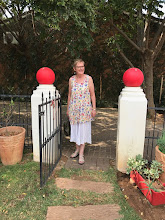
Seraphine de Senlis was the topic of the movie,
Seraphine (2009) that my artist friend, Rhoda and I watched on Saturday evening. I had no previous knowledge of this French painter of Naïve Art and I found her creations and the story of her life moving. Seraphine was born in 1834 in Arsy, France. Orphaned at seven, she spent her childhood in a convent; her early years as a shepherdess and the rest of her life as a household drudge. But Seraphine was driven by her desire to paint – through the nights in the shabby bedsit; through the shelling of her village during WWI; when encouraged by the German art critic, Wilhelm Uhde; and when forgotten and unappreciated in the post-war years until Uhde found her once again. Sadly, her childlike spending of her patron’s money alarmed his sense of caution during the Great Crash and eventually insanity ended her virtually hidden career. She died alone and friendless in a mental asylum in 1934 (some put the date at 1942). She never knew that some of her paintings, brilliant images of leaves, flowers and feathers which seem to swirl and quiver, hang in the Metropolitan Museum of Modern Art, New York.

In the movie Yolande Moreau does a wonderful portrayal of the painter – scrubbing floors, emptying chamber pots and washing linen in the stream. Gazing with affectionate worship at the image of the Virgin Mary, mesmerised by the sunlight dancing on leaves or the image of her own work worn hand submerged in a pail of water. Making her own paints of glowing colours, grinding her mixtures with mortar and pestle from concoctions of mud from river beds, wild flowers from the hedgerows, a vial of blood from the butcher’s bowl and molten wax from the votive candles at Mary’s shrine in the village church.

‘She was obsessed,’ whispered Rhoda to me in the dim light of the cinema. ‘Well, so are you when you get going!’ I answered back. In the seat next to me, a young girl sat weeping. It was that kind of movie. That kind of life – Seraphine de Senlis.
 Seraphine de Senlis was the topic of the movie, Seraphine (2009) that my artist friend, Rhoda and I watched on Saturday evening. I had no previous knowledge of this French painter of Naïve Art and I found her creations and the story of her life moving. Seraphine was born in 1834 in Arsy, France. Orphaned at seven, she spent her childhood in a convent; her early years as a shepherdess and the rest of her life as a household drudge. But Seraphine was driven by her desire to paint – through the nights in the shabby bedsit; through the shelling of her village during WWI; when encouraged by the German art critic, Wilhelm Uhde; and when forgotten and unappreciated in the post-war years until Uhde found her once again. Sadly, her childlike spending of her patron’s money alarmed his sense of caution during the Great Crash and eventually insanity ended her virtually hidden career. She died alone and friendless in a mental asylum in 1934 (some put the date at 1942). She never knew that some of her paintings, brilliant images of leaves, flowers and feathers which seem to swirl and quiver, hang in the Metropolitan Museum of Modern Art, New York.
Seraphine de Senlis was the topic of the movie, Seraphine (2009) that my artist friend, Rhoda and I watched on Saturday evening. I had no previous knowledge of this French painter of Naïve Art and I found her creations and the story of her life moving. Seraphine was born in 1834 in Arsy, France. Orphaned at seven, she spent her childhood in a convent; her early years as a shepherdess and the rest of her life as a household drudge. But Seraphine was driven by her desire to paint – through the nights in the shabby bedsit; through the shelling of her village during WWI; when encouraged by the German art critic, Wilhelm Uhde; and when forgotten and unappreciated in the post-war years until Uhde found her once again. Sadly, her childlike spending of her patron’s money alarmed his sense of caution during the Great Crash and eventually insanity ended her virtually hidden career. She died alone and friendless in a mental asylum in 1934 (some put the date at 1942). She never knew that some of her paintings, brilliant images of leaves, flowers and feathers which seem to swirl and quiver, hang in the Metropolitan Museum of Modern Art, New York.  In the movie Yolande Moreau does a wonderful portrayal of the painter – scrubbing floors, emptying chamber pots and washing linen in the stream. Gazing with affectionate worship at the image of the Virgin Mary, mesmerised by the sunlight dancing on leaves or the image of her own work worn hand submerged in a pail of water. Making her own paints of glowing colours, grinding her mixtures with mortar and pestle from concoctions of mud from river beds, wild flowers from the hedgerows, a vial of blood from the butcher’s bowl and molten wax from the votive candles at Mary’s shrine in the village church.
In the movie Yolande Moreau does a wonderful portrayal of the painter – scrubbing floors, emptying chamber pots and washing linen in the stream. Gazing with affectionate worship at the image of the Virgin Mary, mesmerised by the sunlight dancing on leaves or the image of her own work worn hand submerged in a pail of water. Making her own paints of glowing colours, grinding her mixtures with mortar and pestle from concoctions of mud from river beds, wild flowers from the hedgerows, a vial of blood from the butcher’s bowl and molten wax from the votive candles at Mary’s shrine in the village church. 










